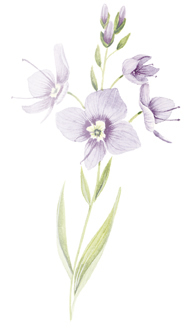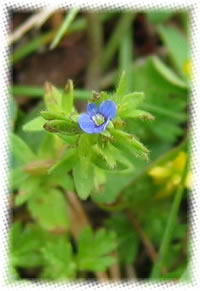Speedwell Veronica officinalis
- Common Names
- Speedwell , common speedwell ,common gypsyweed, Fluellin, Paul's Betony Groundhele
- Botanical Name
- Veronica officinalis
- Family
- PLANTAGINACEAE
Medicinal Uses & Benefits of Speedwell
![]() How to Use|
Side Effects |
Plant & Garden|
Folklore
How to Use|
Side Effects |
Plant & Garden|
Folklore
- Medicinal Uses: * Cough
* Cuts & Wounds
- Properties: * Antiscrofulous * Astringent * Depurative * Diaphoretic * emetic * Expectorant
- Parts Used: flowering plant
- Constituents: organic acids, sugars, flavonoids, resin and tannins.
How to Use: Speedwell
Preparation Methods & Dosage :Tea made from flowering plant, extracts, ointments. If you find this pretty little blue wildflower growing in your yard, try making an herbal tea from the flowering tops.
Speedwell Side Effects: None noted
Plant Description

Common Speedwell - Veronica officinalis
- Flowers:Pale blue, very small, crowded on spike-like racemes from axils of leaves, often from alternate axils. Calyx 4-parted; corolla of 4 lobes, lower lobe commonly narrowest; 2 divergent stamens inserted at base and on either side of upper corolla lobe; a knob-like stigma on solitary pistil
- Stem:From 3 to 10 in. long, hairy, often prostrate, and rooting at joints.
- Leaves: Opposite, oblong, obtuse, saw-edged, narrowed at base.
- Fruit: Compressed heart-shaped capsule, containing numerous flat seeds.
- Preferred Habitat:Dry fields, uplands, open woods.
- Flowering Season:May - August
- Distribution:From Michigan and Tennessee eastward, also from Ontario to Nova Scotia. Probably an immigrant from Europe and Asia
- Flowers:Light blue to white, usually striped with deep blue or purple; structure of flower similar to that of V. officinalis, but borne in long, loose racemes branching outward on stems that spring from axils of most of the leaves.
- Stem:Without hairs, usually branched, 6 in. to 3 ft. long, lying partly on ground and rooting from lower joints.
- Leaves:Oblong, lance-shaped, saw-edged, opposite, petioled, and lacking hairs, 1 to 3 in. long, 1/4 to 1 in. wide.
- Fruit: A nearly round, compressed, but not flat, capsule with flat seeds in 2 cells.
- Preferred Habitat:In brooks, ponds, ditches, swamps.
- Flowering Season:April - September
- Distribution:From Atlantic to Pacific, Alaska to California and New Mexico, Quebec to Pennsylvania
This, the perhaps most beautiful native speedwell, whose sheets of blue along the brookside are so frequently mistaken for masses of forget-me-nots by the hasty observer, of course shows marked differences on closer investigation; its tiny blue flowers are marked with purple pathfinders, and the plant is not hairy, to mention only two. But the poets of England are responsible for most of whatever confusion still lurks in the popular mind concerning these two flowers. Speedwell, a common medieval benediction from a friend, equivalent to our farewell or adieu, and forget-me-not of similar intent, have been used interchangeably by some writers in connection with parting gifts of small blue flowers. It was the germander speedwell that in literature and botanies alike was most commonly known as the forget-me-not for more than two hundred years, or until only fifty years ago. When the Mayflower and her sister ships were launched, "Speedwell" was considered a happier name for a vessel than it proved to be. Netje Blanchan Wild Flowers worth Knowing(1917)
Regional Traditions :European * North America *
History and Traditions & Folklore
The Common Speedwell is a native of the Old World, but is abundantly naturalized in the eastern United States, where it grows in open, grassy placesAn ancient tradition of the Roman Church relates that when Jesus was on His way to Calvary, He passed the home of a certain Jewish maiden, who, when she saw drops of agony on His brow, ran after Him along the road to wipe His face with her kerchief. This linen, the monks declared, ever after bore the impress of the sacred features - vera iconica, the true likeness.
- Grieve, Maud Mrs. "A Modern Herbal" (1931)
- Dr. Duke's Phytochemical and Ethnobotanical Databases












